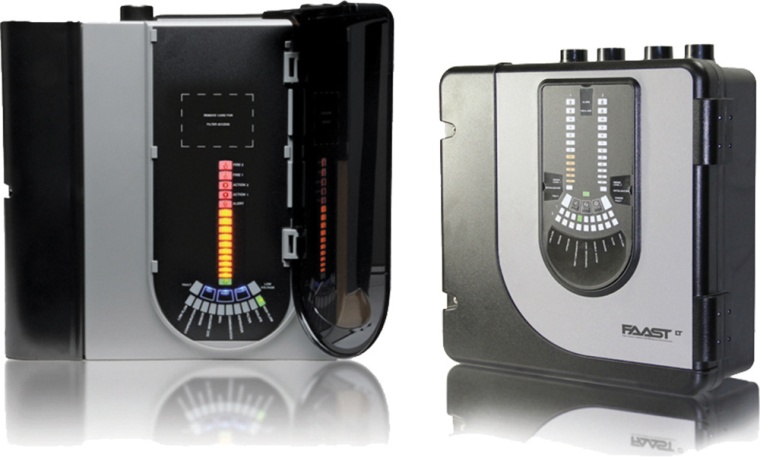Aspiration Smoke Detection Is One of the Fastest Growing Monitoring Principles
GIT SECURITY talked to Honeywells Tim Checketts (EMEA Sales Manager) and Kevin Dennis (Business Development Manager) about the growing popularity of Aspiration Smoke Detection (ASD...

GIT SECURITY talked to Honeywell’s Tim Checketts (EMEA Sales Manager) and Kevin Dennis (Business Development Manager) about the growing popularity of Aspiration Smoke Detection (ASD), and how next generation technologies are broadening the range of applications.
GIT SECURITY: What are the factors driving ASD installation growth?
Tim Checketts: Historically ASD was associated with sensitive detection, so many businesses were either unaware of its additional value aspects or of the belief that they did not need enhanced sensitivity. Technological advancements now available in next generation ASDs like Honeywell’s FAAST (Fire Alarm Aspiration Sensing Technology), highlight the considerable value of this technology for a wide diversity of applications. FAAST combines a number of aspects that make it increasingly popular, like false alarm immunity even in the presence of high dust/dirt and fluctuating environmental conditions. This is advantageous for most sites – and particularly those like waste recycling, wash-down and industrial applications, where the risk of false alarms are significantly increased. A single false alarm results in a 30 minute facility downtime, which is unacceptable in a World where maximised productivity is essential. FAAST uses pioneering filtration techniques, combined with dual optical analysis to ensure reliability where other detection methods are known to fail or fall short. This enables varied applications to cost-effectively leverage the value of sensitive and accurate detection without the risk of generating nuisance alarms, dispelling the myth that increased sensitivity leads to increased false alarms.
Can you show us where ASD is the method of choice?
Kevin Dennis: The intrinsic design of an ASD makes it well suited to complex spaces, difficult to reach locations and areas where aesthetics matter; the system features an advanced dual-laser detector and aspirator, which can be situated outside of the protected area. Air is drawn into the detector via sampling points in the system’s discrete pipe network, located within the protected area at ceiling height either exposed or concealed in a roof void. The pipe work itself requires no maintenance and a single FAAST unit can monitor a space up to 2,000 m² or 4,000 m² using a dual-channel variant, replacing many points of detection that would require both wiring and individual maintenance.
Less maintenance is another benefit of ASD?
Tim Checketts: Yes, the ability to reduce ongoing testing and maintenance is a key factor in ASDs growing install base. FAAST only requires minimal maintenance on the device itself and features simplified ground level testing that can be carried out by a single operator, with no need for additional equipment or process shutdown. Applications like cold storage and food processing operate 24/7 so this aspect is essential. This value also makes FAAST popular in hard-to-access locations such as voids and lift shafts, preventing out of hours maintenance. System design is simplified by FAAST’s three-in-one design, configuration and monitoring PipeIQ software, so large open spaces like shopping malls and leisure centres, where challenges like smoke stratification and solar gain exist, or warehouses, where racking must be accommodated, can be easily overcome at the design stage.
Kevin Dennis: Aside from the design features mentioned, macro trends are also driving ASD popularity. Insurance stipulations are becoming stricter; particularly in high risk industries like waste recycling. FAAST is proven to be 300 times more effective than comparable fire detection, which was confirmed by independent testing by the University of Maryland. This helps to mitigate risks for both high risk applications and businesses that self-insure – a growing trend in the wake of rising insurance premiums. An advanced ASD solution is therefore able to deliver on all the performance levels required, with the added benefit of also reducing costs. Our growing install base has led to many positive testimonials and case studies, which help to showcase ASDs versatility and proven performance. Real-world examples are powerful and add confidence to those considering ASD.
Within which applications is ASD integration growing fastest?
Tim Checketts: The biggest growth is within heavy industrial applications and power/nuclear generation where regulations demand enhanced safety solutions. FAAST’s Independent Nuclear Compatibility Testing demonstrates its environmental resilience in conditions ranging from -28°C up to +65°C and from 0 up to 95% condensation/humidity and k3 seismic stability up to 9G. The increase in terror threats has also changed the safety landscape. False alarms are now treated as real alarms, leading to ASD install growth in rail and underground transportation applications. Aspects like FAAST’s five stage alert and double confirmation are advantageous in such environments. We are also seeing growth within EN54-20 Class C applications like high-end residential, hotels and historic buildings where aesthetics matter. FAAST’s whisper quiet detection, near-invisible pipe network and easy installation into ceiling voids adapt well to such environments. ASD also offers more integration flexibility and maintenance reduction capability than traditional point detection, which up until recently was preferred in such applications.
What is the future of ASD in terms of integration and design evolution?
Kevin Dennis: Generally speaking, the evolution of ASD will mirror that of all technologies; a refinement of its features to ensure an even greater flexibility, ease of use and reliability. The trend of ASD integration into BMS systems will continue to grow, so future design evolution will permit increased integration flexibility and simplicity. The combination of both ASD and gas detection would be of great value to the marketplace and represents the next big evolutionary step for ASD technology. Many industries like petrochemical plants, distilleries and biomass applications would benefit from a single solution with dual detection. Such technology would also benefit data centres where hydrogen detection from backup batteries is required and high-end residential environments or hotels, where smoke and carbon monoxide detection is essential.













